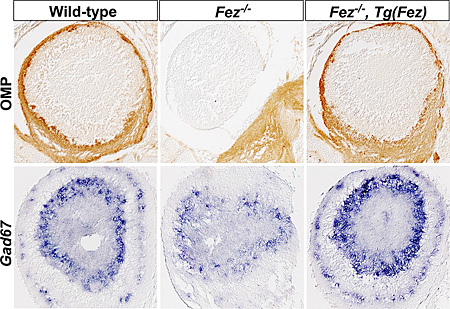| Olfactory bulb development follows Fez |
 |
 |

March 25, 2006 – Working out the means by which structurally complex, multi-component tissues and organs are formed is one of the central questions in developmental biology, and one of especial interest to the field of neurodevelopment, where complexity is taken to new levels in the organization of the vertebrate brain. That remarkable convolution is evident in the mammalian olfactory bulbs, two structures that jut rostrally from the forebrain to receive inputs from axons extending from neurons in the epithelium of the nose. The olfactory bulbs consist of layers upon layers of functionally and morphologically distinct neural tissue, organized roughly in onion-skin fashion, such that the outermost layer of olfactory sensory neurons is underlain successively by a glomerular layer of projection neurons interspersed with periglomerular cells; the external plexiform layer; the mitral cell layer; the internal (or fibrous) plexiform layer, which receives axons projecting from the glomerular neurons; a granule cell layer; and finally, at the base, the subventricular zone, which provides a constant supply of interneurons, periglomerular cells and granule cells throughout the life of the individual. Needless to say, the genetic blueprint that allows the embryo to generate this ingeniously multilayered structure is a subject of great interest to students of neurodevelopment.
 |
| Expression of OMP protein and Gad67 transcripts, which mark axons of olfactory sensory neurons and interneurons, respectively, in wild-type, Fez-deficient (Fez-/-), and Fez-/- mice in which Fez expression was rescued under the control of the olfactory sensory neuron-specific promoter (Fez-/-, Tg(Fez)). Fez is required in olfactory sensory neurons for axon targeting and layer formation of olfactory bulbs. |
Tsutomu Hirata, in the Laboratory for Vertebrate Axis formation (Masahiko Hibi; Team Leader), working in collaboration with the Laboratory for Neurobiology of Synapse (Yoshihiro Yoshihara; Team Leader) in the Brain Science Institute of RIKEN and the National Institute of Neuroscience (Tokyo, Japan), now reports for the first time direct genetic evidence that the development of the olfactory bulb is regulated extrinsically by signals from the sensory neurons of the olfactory epithelium. Their article, which appeared in the March 15 online edition of Development, explains how the gene Fez guides axons from the olfactory epithelium to innervate the bulbs during the embryonic development of the mouse.
“We knew of certain cell-autonomous genetic factors needed for olfactory bulb development,” says study leader Masahiko Hibi, “and there had been some indirect evidence of extrinsic determination as well. What we wanted to do here was provide genetic confirmation of a non-cell-autonomous regulator of its formation, and I think Tsutomu has succeeded in doing just that.”
The team was first clued to a possible role for Fez by its pattern of expression, which shows that it (along with its relative, Fez-like) is expressed specifically in forebrain and olfactory sensory neurons. On testing for function by generating Fez-deficient mice, Hirata et al. found that while heterozygotes appeared normal, homozygous mutants died soon after birth. Strikingly, the Fez-/- animals exhibited a range of defects in the formation of the olfactory bulb, including failure of olfactory sensory neurons to reach their destination in the bulbs and size reductions and disorganized layer formation of the olfactory bulbs themselves. These mice also showed aberrant rostral migration of the interneuron progenitors that normally emanate from the subventricular zone of the lateral ganglionic eminence in the telencephalon, but interestingly, the effect did not appear to be dependent on the known molecular regulators of that process. The team next used plasmid-mediated expression of the gene to determine whether Fez in the olfactory sensory neurons controls the formation of the olfactory bulb non-cell-autonomously, and found that the transgene was sufficient to rescue the phenotype, in full or in part.
This series of experiments by Hirata and colleagues provides the basis for a new understanding of olfactory bulb development at the genetic level, and at the same time opens up new avenues for investigation into functional interactions between the olfactory sensory neurons and their developmental targets. The means by which the sensory neuronal axons direct the migration of interneurons is particularly interesting, as the two do not come into physical contact during the earliest stages of bulb development. It remains to be seen whether the effect is dependent on a diffusible guidance signal capable of bridging the distance between sensory and inter-neurons, or secondary to a defective wiring of the olfactory sensory and projection neurons in the olfactory bulbs caused by loss of Fez function. Whatever the answer may be, Hirata et al. have provided a new foothold for progress toward a better understanding of how the machinery of olfaction is born.
|

